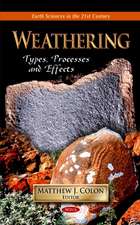Foot Steps of the Ancient Great Glacier of North America: A Long Lost Document of a Revolution in 19th Century Geological Theory
Autor Harold W. Borns, Jr., Kirk Allen Maaschen Limba Engleză Hardback – 6 feb 2015
| Toate formatele și edițiile | Preț | Express |
|---|---|---|
| Paperback (1) | 636.30 lei 6-8 săpt. | |
| Springer International Publishing – 6 oct 2016 | 636.30 lei 6-8 săpt. | |
| Hardback (1) | 642.51 lei 6-8 săpt. | |
| Springer International Publishing – 6 feb 2015 | 642.51 lei 6-8 săpt. |
Preț: 642.51 lei
Preț vechi: 755.88 lei
-15% Nou
Puncte Express: 964
Preț estimativ în valută:
122.94€ • 128.11$ • 101.80£
122.94€ • 128.11$ • 101.80£
Carte tipărită la comandă
Livrare economică 03-17 aprilie
Preluare comenzi: 021 569.72.76
Specificații
ISBN-13: 9783319131993
ISBN-10: 3319131990
Pagini: 202
Ilustrații: X, 202 p. 8 illus.
Dimensiuni: 155 x 235 x 17 mm
Greutate: 0.48 kg
Ediția:2015
Editura: Springer International Publishing
Colecția Springer
Locul publicării:Cham, Switzerland
ISBN-10: 3319131990
Pagini: 202
Ilustrații: X, 202 p. 8 illus.
Dimensiuni: 155 x 235 x 17 mm
Greutate: 0.48 kg
Ediția:2015
Editura: Springer International Publishing
Colecția Springer
Locul publicării:Cham, Switzerland
Public țintă
Popular/generalCuprins
Part I John Kimball DeLaski.- Biographical sketch.- The manuscript.- Part II The Ancient Great Glacier of North America.- Preface.- The phenomena of boulder drift.- Carver’s Harbor.- Research on rocks.- Vinalhaven and North Haven.- Camden Hills and Mount Desert.- Mount Desert to Holden.- Bangor to the Piscataquis Valley.- Mount Katahdin.- The inescapable conclusion - A large glacier.- Evidence from all over North America.- Boulder drift theories.- Objection to iceberg theory continued.- An astronomical theory.- Astronomical theory continued.- Theory of mutable axis of the earth.- Continental upheaval and subsidence.- The changeable relations of land and water.- Supposed cause of the cold period.- Geologic record since the Devonian.- The climate cools.- A glacial time.- Duration of the glacial age.- End of the glacial age.- On the motion of glaciers.- Purpose of the glacier.- Late-glacial cold-water marine shells of Maine and adjacent regions.
Recenzii
“This book is a treasure for natural scientistsinterested in the emergence of 19th-century thought. Summing Up: Recommended.Graduate students and researchers/faculty.” (J. D. Ives, Choice, Vol. 53 (1),September, 2015)
Notă biografică
Harold William Borns, Jr. is Professor Emeritus of Glacial and Quaternary Geology at the University of Maine. He has taught geology for 50 years and in retirement has continued Ice Age field research projects in Maine, Denmark and Ireland. Professor Borns has had published about 150 peer-reviewed scientific journal articles, made many geological maps for the Maine Geological Survey and has co-authored one book on the Ice Age. He spent 28 field seasons leading glacial geological research teams in Antarctica and served as Program Manager for Polar Glaciology in the Office of Polar Programs at the U.S. National Science Foundation for three years. He formed the “Climate Change Institute” at the University of Maine in 1973 and served as its director for the first 15 years.
Kirk Allen Maasch is Professor of Climate Studies at the School of Earth and Climate Sciences and the Climate Change Institute at the University of Maine. He has had published over 60 peer-reviewed scientific journal articles and book chapters, and has co-edited one book on climate and culture.
Kirk Allen Maasch is Professor of Climate Studies at the School of Earth and Climate Sciences and the Climate Change Institute at the University of Maine. He has had published over 60 peer-reviewed scientific journal articles and book chapters, and has co-edited one book on climate and culture.
Textul de pe ultima copertă
Dr. John K. DeLaski practiced medicine in the Penobscot Bay region of Maine and, in addition, was a naturalist with keen powers of observation. His study of the landscape led to his conclusion that a thick glacier had overtopped the highest hills, filled all of Penobscot Bay, extended far to the east and west and probably was part of a greater continental glacier. He published these observations and inferences in numerous local newspapers and magazines, as well as the American Journal of Science. His work put him on the “team” of Benjamin Silliman, James D. Dana and Louis Agassiz, all advocates for glaciation as the regional land shaping force as opposed to that of the Biblical Deluge, a major scientific conflict of the day both in North America and Europe. Agassiz and other prominent naturalists incorporated DeLaski’s observations into their own presentations, often without giving him credit.
Published now for the first time, DeLaski’s summary work presents a holistic discussion of the controversy in which he presents his critical observations of surficial geology in Maine, southern New England and New Brunswick, Canada and concludes that these depositional and erosional features must be of glacial origin. All this was done while most “naturalists” still advocated the Biblical Flood to explain the major components of surficial geology in North America and abroad.
Published now for the first time, DeLaski’s summary work presents a holistic discussion of the controversy in which he presents his critical observations of surficial geology in Maine, southern New England and New Brunswick, Canada and concludes that these depositional and erosional features must be of glacial origin. All this was done while most “naturalists” still advocated the Biblical Flood to explain the major components of surficial geology in North America and abroad.
Caracteristici
A never-before published work by one of the most influential proponents of the role of glaciations in the morphology of the north American landscape This is the earliest book in North America (1869) that presents critical field evidence for widespread glaciation, in contrast to the biblical flood, to account for the surficial geology of Maine, New England and New Brunswick, Canada This book documents a rare and important transition in geological thought produced during the heated arguments between advocates of the Flood vs. glaciations during the mid 1800’s Includes supplementary material: sn.pub/extras













